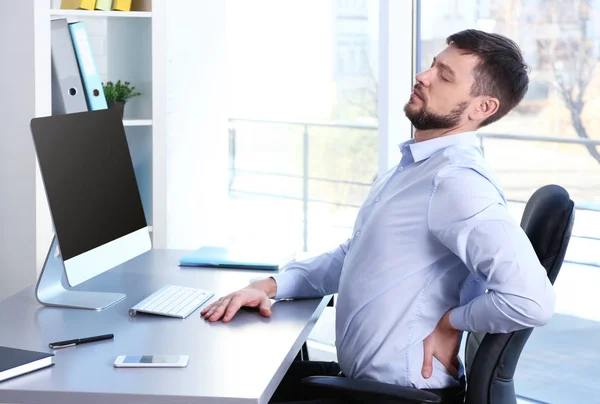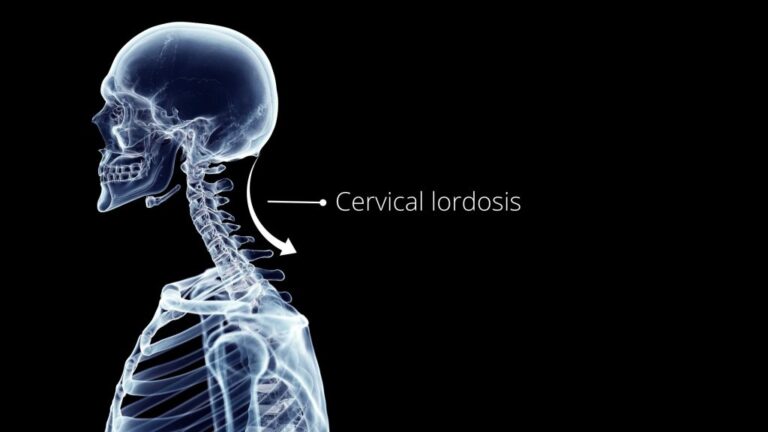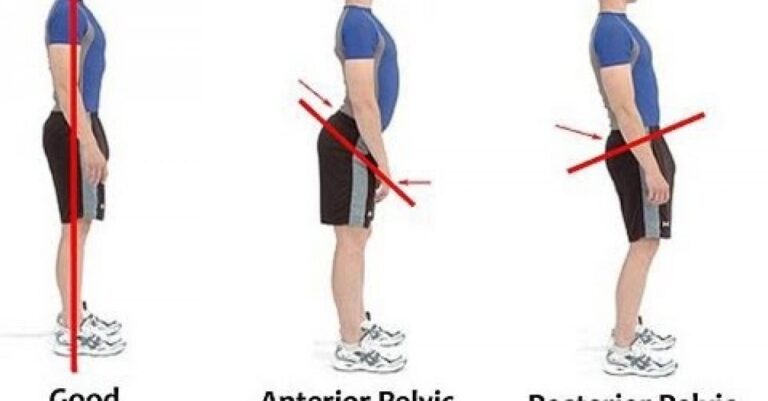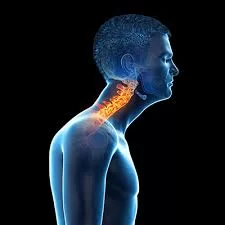Poor Posture
- Poor posture results from certain muscles tightening up or shortening while others outstretch and become weak, which frequently occurs as a result of one’s daily activities. It may lead to pain, injury, or other health-related problems.
- There are different factors that can have an impact on posture, including occupational activities and biomechanical factors similar to force and repetition. Risk factors for poor posture also include psychosocial factors similar to job stress and strain. Workers who have advanced job stress are more likely to develop neck and shoulder symptoms. Poor posture may lead to injuries similar to lordosis.
Table of Contents
Types of Poor posture:
Poor posture can present in several ways:
- It can present with rounded shoulders and elevated shoulders and a pushed-forward head position. This position places stress on the spine between the top of the neck and cranium and the base o the neck and upper shoulders. There’s a reduction in the stability of the shoulder blades resulting in changes to the movement pattern of the upper extremities.
- It can present with a forward tilting of the hips, an increase in the curve of the lumbar spine, and a protruding abdomen. This position places stress on both the hip joints and lower back.
- lordosis: lumbar Lordosis is the inward curve of the lumbar spine at the level of I1 to l5. A small degree of lordosis is normal. Too much curving is called swayback.
- kyphosis: Kyphosis is an exaggeration of the posterior spinal curve localized to the dorsal spine, forward rounding of the upper back. kyphosis is also known as arcuate, round back, or Kelso’s hunchback.
- most commonly seen in older women is known as the dowager’s hump.
- sway back: The sway back posture — casually called the ‘lazy posture’, is identified by shoulders and chest leaning backward position, with hips turned in and pelvis and chin thrust forward.
- Swayback posture is a particular type of poor posture that frequently create lower back pain. People who exhibit swayback posture have exaggerated curves in their spine curve, forward-tilting hips, and the appearance of leaning back when standing posture.
Does Poor Posture Cause Back Pain?
- If you suffer from unending back pain still, it’s one of the factors that can cause bad posture, It’s very easy to accidentally take a squat position when you’re tired or concentrating on something. still, sitting continuously in the incorrect posture puts unnecessary muscles strain on the spine and surrounding muscles. Here are the consequences of poor posture and the way you can take to correct them.
- When you use the wrong posture, several areas of stress may develop within your muscle tissue, spinal joints( lumbar facets), and discs. These stresses may be relieved once the offending posture is right or may continue to accumulate, slowly weakening the affected structure, for example, Prolonged hunching while standing or sitting can cause your back, core, and abdominal muscles to come strained and painful, decrease their blood supply, and slowly developing stiffness and weakness in the trunk and lower back muscles. An unsupported sitting position places a small forward flex on the spine. Over time, this forward bend posture may place a load on the lower spinal discs, causing disc herniation.
- A wrong-lifting technique can cause your lumbar disc to herniate, causing it to refer to pain in the lower back and/ or radiate the pain into your leg throughout a nearby spinal nerve. Working on a laptop or reading while lying on your stomach can cause your lower back and hipsterism to extend( bend backward)excessively, altering the mechanics of the lower lumbar spinal curve.
- It generally takes less effort to maintain a right posture than a wrong posture. Changing from a habitual incorrect posture may take time and constant awareness.
Symptoms of Poor posture:
- Back pain is a sort of muscle pain with a shooting, burning, or sharp feeling. The pain may give out down your leg or get worsen with bending, lifting, standing, or walking.
- The Health Cost of Poor Posture
- still, take a look at the potential negative health effects of bad posture, If you need a little motivation to improve how you sit and stand all day. The largest health impact is a distortion of the natural curve of the spine. Your spine does not have to be straight; there are three natural curves that support the rest of your body. When you squat, your spine shifts, creating a load in your vertebral joints. Bad Posture can result in easy-to-feel pain in the lower back and shoulders. You may also experience pain in other areas of your body because causes muscle imbalances.
- furthermore, chronic pain and poor posture can lead to internal problems affecting the digestive and cardiovascular systems. Because they hold the intestines in an unnatural way. This can prevent your body from effectively digesting food, which can lead to gas and general discomfort. It also slows circulation, making it much more difficult for the body to heal itself from injuries. Bad posture can affect how you appear to another. Standing upright makes you look confident and relaxed, but crouching can make you look shy.
The Negative Effects of Sitting All the Day
- The NHS endorses that adults elderly 19- 16 four must do at least a hundred and 50 minutes of moderate-depth pastime every week or seventy-five minutes of vigorous-depth pastime every week. Longtime sitting can motivate lower back pain, in particular, if you’re sitting incorrectly, still, that’s now no longer all. An examination through The American magazine of preventive medications found that better degrees of general every day sitting time are related to an expanded hazard of cardiovascular sickness and diabetes as properly as bad posture Low mood Chronic pain
Risk Factors
- Back pain can affect anyone, including children and younger. The following factors may increase your risk of developing back pain aging. Back pain starts in your 20s or 40s and becomes more common as you get older. Lack of exercise. Weak muscles, and back and abdominal muscles can cause back pain. Excess weight. Excess body weight puts redundant stress on your reverse. conditions. Many types of arthritis and cancer can contribute to reverse pain. indecorous lifting. Using your lower back instead of your legs can cause back pain. Psychological condition. People vulnerable to depression and anxiety appear to be at great risk of back pain. Smoking. Smokers experience increased back pain. This can be because smoking can increase coughing, which can lead to a herniated slice. Smoking can also decrease blood flow to the spine and increase the risk of osteoporosis.
How to Correct Poor Posture?
- Fortunately, there are many ways to right bad posture. These can range from big changes like changing your exercise regimen to little changes like adding extra support to your chair. There are many ways to correct bad posture.
Strengthen your Back and Core
- One of the motives humans broadens terrible posture within side the first location is due to the actuality the muscular tissues of their torso are t strong. When you give a boost to the muscular tissues on this part of your body, it’ll become a great deal simpler to maintain your lower back up exceptional and straight. There are several approaches you may pass approximately doing this. Lifting small weights may be very beneficial for constructing up energy, but still insure to stretch out your muscular tissues after lifting to save you from getting tense. Yoga and Pilates sporting activities are each very beneficial for constructing energy and managing this area. Pilates focuses extra on firming the muscular tissues, even as yoga activity is amazing for lengthening the muscular tissues and growing muscle mobility. If you didn’t have time to visit a class. you may appear up sporting activities online to try.
Effective exercises to improve Poor posture
Glute bridge

- Benefits: Glute bridge exercise can help strengthen your core muscles and glute muscles.
To do this exercise:
- Start by lying on your back, with your knees flexed at 90 degrees and your arms flat against the ground by your sides. Turn your feet out slightly.
- Push into the ground with your feet and lift your hips by squeezing your glutes, until there is a straight line from your knees to your shoulders.
- stop for a couple of seconds, then back to the starting position.
- Do one to 2 sets of 15 repeats to start.
- Try to work up to 3 sets as you improve your core strength.
Plank

- Benefits: This Exercise can help strengthen your abdominal muscles, glute muscles, shoulders, and upper back muscles.
To do this exercise:
- Lie faces down on a comfortable soft surface like a yoga mat.
- Push yourself up onto your toes and palms area, with your body in a straight line from your head to your ankles. If this is too intense, try starting with a low plank exercise: raise just onto your forearms instead of straightening your arms all the way.
- Remain your stomach and glutes braced as you hold this position.
- Hold for at least 30 seconds.
Kneeling hip flexor stretch
- longtime sitting can cause hip flexor muscles to tighten, but stretching will help loosen them again.
- hip flexor stretch helps to loosen the muscles and lengthen tight hip flexor muscles.
- Kneel down on the left knee, ensuring that the proper knee is directly over the right ankle.
- Place both hands on the right thigh muscle for stability. Make sure the spine is tall and straight.
- Tighten the glutes and abdominal muscle, and keep the pelvis in a neutral position.
- Lean forward position into the proper hip, ensuring the pelvis and back remain stable. There should be a stretch in the hip flexor muscle and inner thigh muscle.
- Hold this position for 20 to 30 seconds. Repeat 5 times, aiming to stretch a little more with each repetition.
- change sides and repeat the above process to stretch the other hip flexor muscles.
See a Physiotherapist and chiropractor regularly
- Another easy way to reduce back pain is to contact a Physiotherapist and chiropractor. However, adjustments are used by chiropractors to return the spine to its original position, If the chine has shifted. Not only will these adjustments help relieve chronic pain, but they’ll also make it much easier to maintain good posture in the future. Chiropractors take a holistic approach to treatment, so they can help manage chronic pains and pains not only in the back but throughout the body as well. In addition to providing stretching and exercise to help correct your poor posture, it can also help you make positive changes by evaluating your diet plan, exercise, sleep, and other factors that can affect your health.
Buy a helpful desk chair and mattress
- If you spend a long time sitting at work, the chair you use can have a huge impact on your posture, If the chair is uncomfortable and doesn’t support the natural curve of the back. it’s easy to assume a squat position as a result, Instead of straightening your body unnaturally, find a desk chair with a high back that follows the curve of your spine. They also want to be made of supportive and lightweight materials to keep your muscles feeling good and comfortable.
- You must also use a supporting mattress. A bad quality mattress can cause back pain and spinal imbalances, which negatively affect your posture during waking hours. Ideally, the mattress should be made of supportive memory foam that supports the contours of the body without feeling sagging. However, you can also buy a cheap mattress topper for extra bed support, If you do not want to invest in a new mattress. you can also buy a cheap mattress topper for extra bed support.
Be sensitive to your alliance
- A big part of correcting your poor posture is to increase your awareness of your posture throughout the day. This can be difficult to get used to if you have not done it in the past, but with a short practice, it’ll become second nature to you. There are many things you can do to remind yourself to observe your posture. You can try wearing a bright bracelet or ring similar with good posture as it reminds you to sit up straight every moment you look at it. You may want to ask a friend, partner, or family member to remind you to stand up straight when you show yourself slumped. When standing, Consider keeping your shoulders above your hip area and your feet and knees in a straight line. Keep your shoulders relaxed and your knees slightly flexed. This may take some practice, but over time you’ll learn to accept this position naturally. However, see a chiropractor or doctor, If you’re still having trouble maintaining good posture.
How do prevent Poor posture?
- Back pain can signal a serious medical problem. Seek immediate care if your back pain. By learning and practicing proper body mechanics to improve your physical condition, you can help back pain or prevent it from recurring.
- To keep your back healthy and strong Exercise. Regular, low-impact aerobic exercise that does not strain or shake your back can increase back strength and endurance and improve muscle function. Walking and swimming are good options. Talk to your doctor about what actions you can try. Development of muscle strength and flexibility. Core- strengthening abs and back exercises help develop your muscles to work together like a natural corset for your spine. Maintain a healthy weight.
- Excessive weight puts a strain on the back muscles. However, pruning can help prevent back pain, If you’re fat. Quit smoking. Smoking increases your risk of low back pain. The risk increases with the number of cigarettes smoked per day, so quitting should help decrease this risk. Avoid movements that twist or strain your back muscles. Use your body properly and stand smart. Do not slouch.
- Maintain a neutral pelvic position. However, place one bottom on a low footstool to take some of the load off your lower back, If you must stand for long periods. Alternate feet. Right posture can reduce the stress on back muscles. Sit smart. Choose a seat with lumbar support, armrests, and swivel support. Placing a pillow or dry towel on your back can support maintaining a normal curve. Keep your knees and hips in the same position. Change positions constantly, at least every 30 minutes.
Lift carefully
- To lift a heavy object from the bottom, squat down in front of the object by keeping a straight back and bending your knees. grasp the object close to your chest while you straighten your knees to stand up.
- To lift lighter objects, take support from a table or a counter with one hand, bend down at your hipsterism( keeping a straight back), and raise one leg backward for counterbalance. Use the other hand to lift the object. This technique is called the golfer’s lift and is specifically useful for repetitive lifting activities.
- Smart Pickup. Avoid lifting weighty objects as much as possible, and if you have to lift heavy objects, use strength in your legs. Keep your back straight and bend your knees without twisting. Keep your weight close to your body. However, find a lifting partner, If the object is weighty or uncomfortable.
FAQ
What are the signs of poor posture?
Rounded shoulders.
Potbelly.
Bent knees when standing or walking.
Head that either leans forward or backward.
Back pain.
Body aches and pains.
Muscle fatigue.
Headache.What are the most common posture problems?
Common posture problems
Forward head. Forward head posture is when your head is positioned with your ears in front of the perpendicular midline of your body.
Kyphosis. Kyphosis refers to an exaggerated curvature of your upper back area (the thoracic spine) where the shoulders are rounded forward.
Swayback.
Flat back.Which is an example of poor posture?
Bad posture, or poor posture, is a body position that is asymmetrical or non-neutral position. For example, if you have an excessively large curve in the back (a “swayback,” or lordosis), that is considered poor posture.
How can I correct my posture?
Stand straightway and tall with your shoulders back.
Keep your head level in line with your body.
Pull in your abdomen.
Keep your feet shoulder-width apart.
Don’t lock your knees.
Bear your weight primarily on the balls of your bases.
Let your hands hang naturally at your sides.What are the characteristics of good posture?
Proper posture requirements:
Good muscle flexibility.
Normal motion in the joints.
Strong postural muscles.
Good balance of muscles on both sides of the spine.
Awareness of your own posture, plus awareness of the right posture leads to conscious correction.







38 Comments